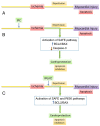BCL2‑regulated apoptotic process in myocardial ischemia‑reperfusion injury (Review)
- PMID: 33155658
- PMCID: PMC7723511
- DOI: 10.3892/ijmm.2020.4781
BCL2‑regulated apoptotic process in myocardial ischemia‑reperfusion injury (Review)
Abstract
The leading cause of death in developed countries is cardiovascular disease, where coronary heart disease is the main cause of death. Myocardial reperfusion is the most significant method to prevent cell death after ischemia. However, restoration of blood flow may paradoxically lead to myocardial ischemia‑reperfusion injury (MI/RI) accompanied by metabolic disturbances and cardiomyocyte death. As the myocardium has an extremely limited ability to regenerate, the mechanisms of regulated cell death, including apoptosis, are the most significant for contemporary research due to their reversibility. BCL2 is a key anti‑apoptotic protein. There are several signaling pathways and compounds regulating BCL2, including PI3K/AKT and MEK1/ERK1/2, JAK2/STAT3, endothelial nitric oxide synthase, PTEN, cardiac ankyrin repeat protein and microRNA, which can serve as targets for modern methods of cardioprotective therapy inhibiting intrinsic apoptosis and saving viable cardiomyocytes after MI/RI. The present review considers the mechanisms of Bcl2‑regulated apoptosis in the development and treatment of MI/RI.
Keywords: myocardial ischemia-reperfusion injury; BCL2; apoptosis; regulated cell death; cardioprotective therapy.
Figures



References
-
- Rogalińska M. Alterations in cell nuclei during apoptosis. Cell Mol Biol Lett. 2002;7:995–1018. - PubMed
-
- Galluzzi L, Vitale I, Aaronson SA, Abrams JM, Adam D, Agostinis P, Alnemri ES, Altucci L, Amelio I, Andrews DW, et al. Molecular mechanisms of cell death: Recommendations of the Nomenclature Committee on Cell Death 2018. Cell Death Differ. 2018;25:486–541. doi: 10.1038/s41418-017-0012-4. - DOI - PMC - PubMed
Publication types
MeSH terms
Substances
LinkOut - more resources
Full Text Sources
Research Materials
Miscellaneous

